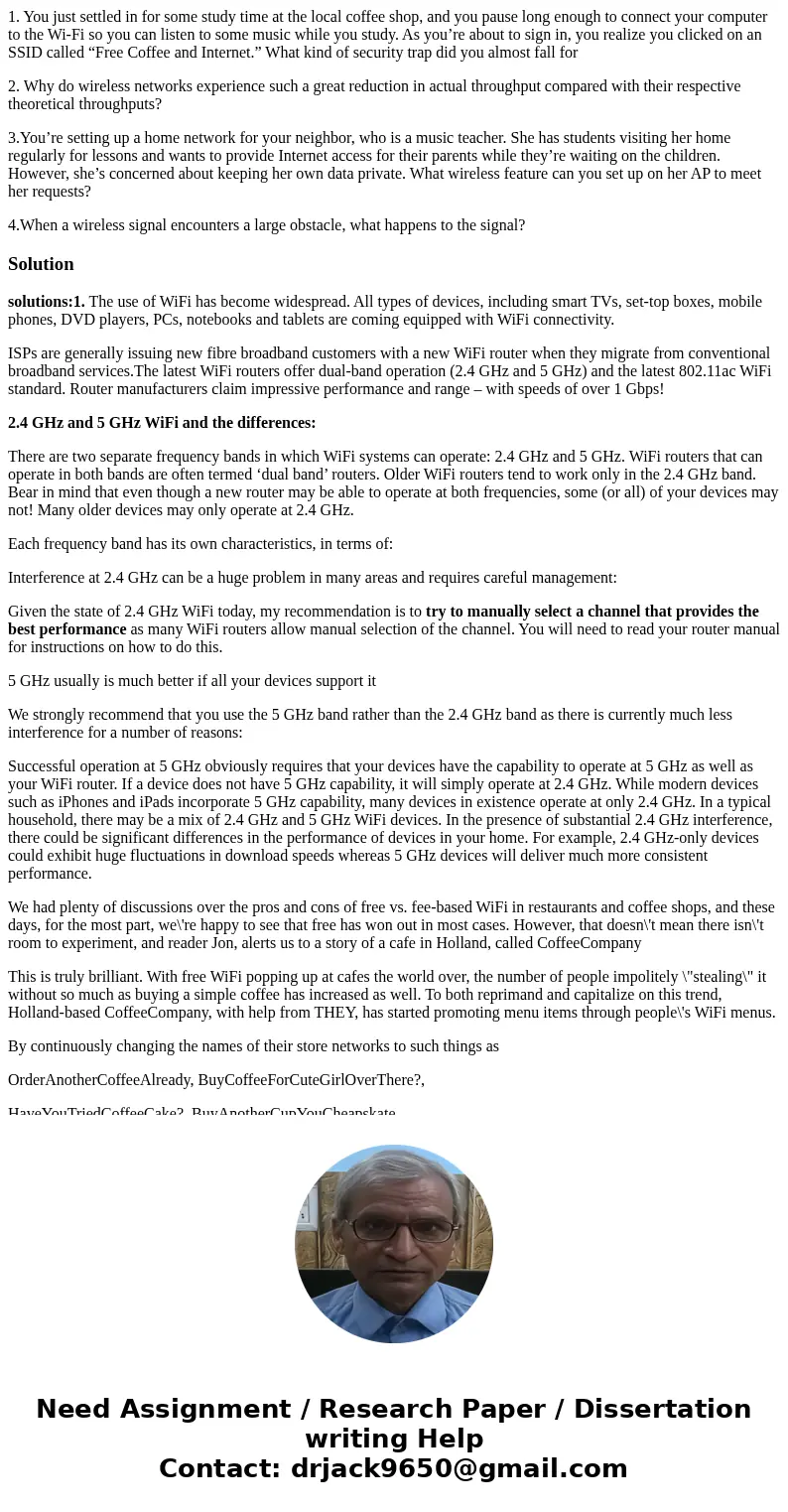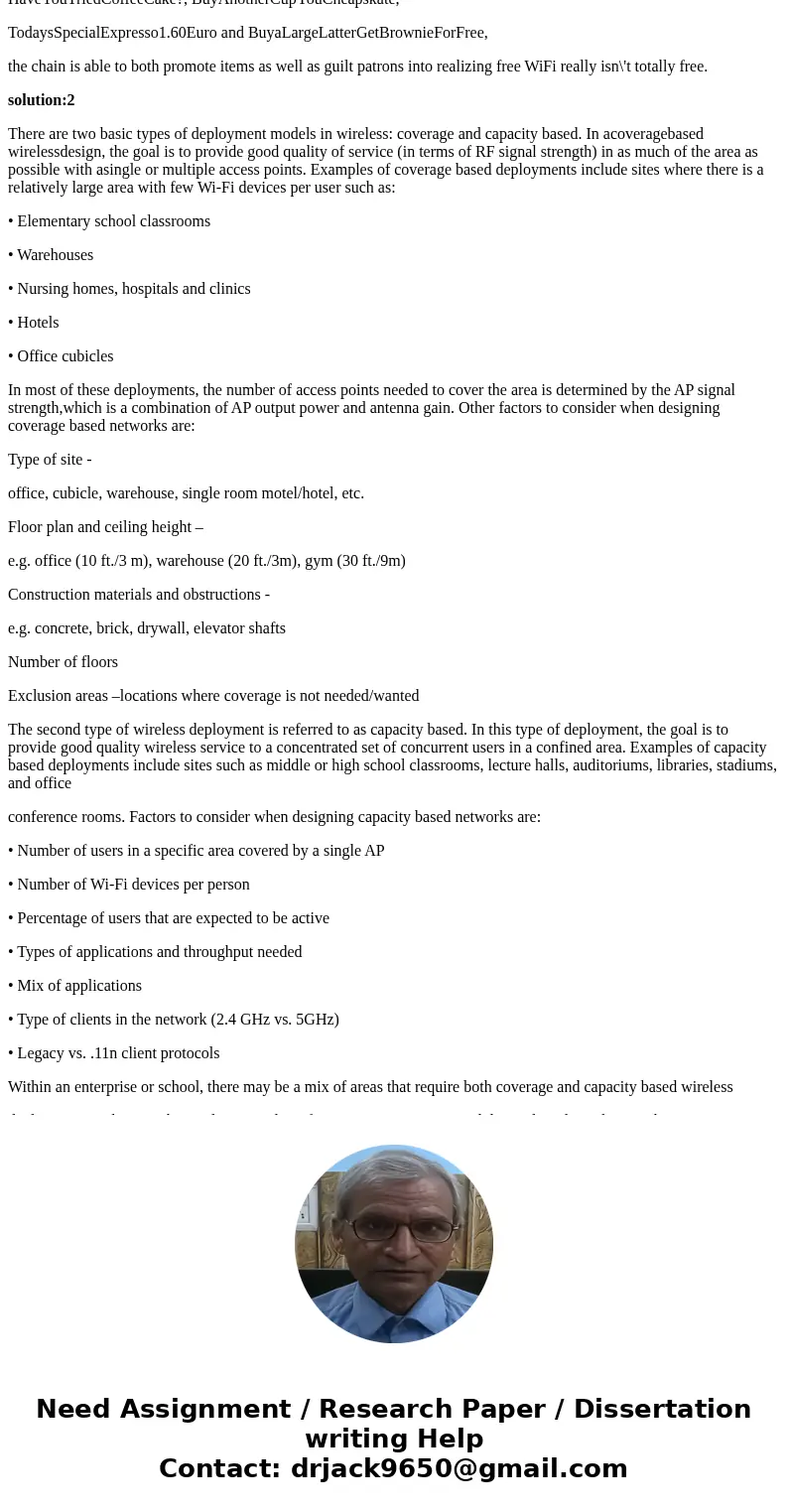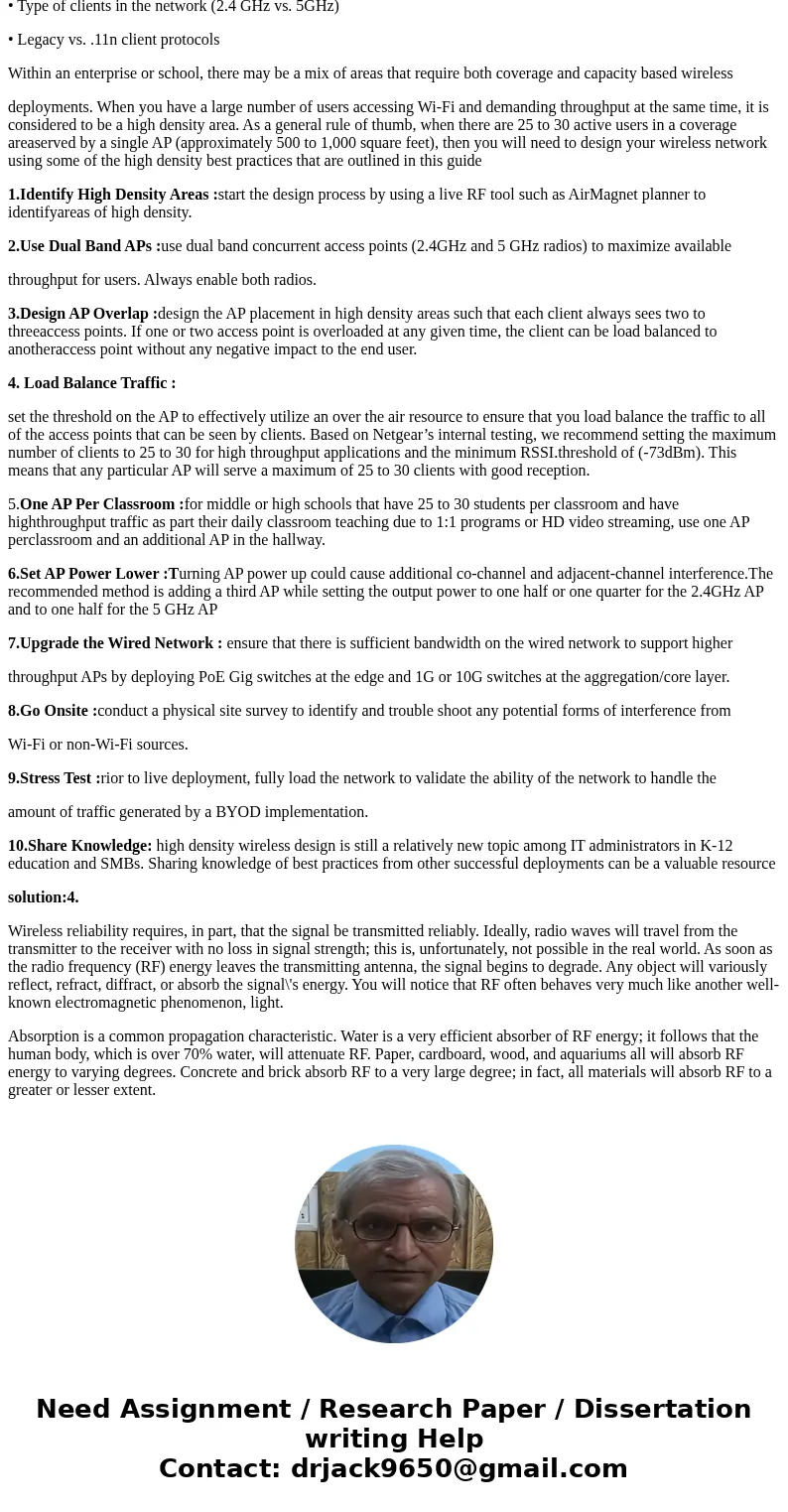1 You just settled in for some study time at the local coffe
1. You just settled in for some study time at the local coffee shop, and you pause long enough to connect your computer to the Wi-Fi so you can listen to some music while you study. As you’re about to sign in, you realize you clicked on an SSID called “Free Coffee and Internet.” What kind of security trap did you almost fall for
2. Why do wireless networks experience such a great reduction in actual throughput compared with their respective theoretical throughputs?
3.You’re setting up a home network for your neighbor, who is a music teacher. She has students visiting her home regularly for lessons and wants to provide Internet access for their parents while they’re waiting on the children. However, she’s concerned about keeping her own data private. What wireless feature can you set up on her AP to meet her requests?
4.When a wireless signal encounters a large obstacle, what happens to the signal?
Solution
solutions:1. The use of WiFi has become widespread. All types of devices, including smart TVs, set-top boxes, mobile phones, DVD players, PCs, notebooks and tablets are coming equipped with WiFi connectivity.
ISPs are generally issuing new fibre broadband customers with a new WiFi router when they migrate from conventional broadband services.The latest WiFi routers offer dual-band operation (2.4 GHz and 5 GHz) and the latest 802.11ac WiFi standard. Router manufacturers claim impressive performance and range – with speeds of over 1 Gbps!
2.4 GHz and 5 GHz WiFi and the differences:
There are two separate frequency bands in which WiFi systems can operate: 2.4 GHz and 5 GHz. WiFi routers that can operate in both bands are often termed ‘dual band’ routers. Older WiFi routers tend to work only in the 2.4 GHz band. Bear in mind that even though a new router may be able to operate at both frequencies, some (or all) of your devices may not! Many older devices may only operate at 2.4 GHz.
Each frequency band has its own characteristics, in terms of:
Interference at 2.4 GHz can be a huge problem in many areas and requires careful management:
Given the state of 2.4 GHz WiFi today, my recommendation is to try to manually select a channel that provides the best performance as many WiFi routers allow manual selection of the channel. You will need to read your router manual for instructions on how to do this.
5 GHz usually is much better if all your devices support it
We strongly recommend that you use the 5 GHz band rather than the 2.4 GHz band as there is currently much less interference for a number of reasons:
Successful operation at 5 GHz obviously requires that your devices have the capability to operate at 5 GHz as well as your WiFi router. If a device does not have 5 GHz capability, it will simply operate at 2.4 GHz. While modern devices such as iPhones and iPads incorporate 5 GHz capability, many devices in existence operate at only 2.4 GHz. In a typical household, there may be a mix of 2.4 GHz and 5 GHz WiFi devices. In the presence of substantial 2.4 GHz interference, there could be significant differences in the performance of devices in your home. For example, 2.4 GHz-only devices could exhibit huge fluctuations in download speeds whereas 5 GHz devices will deliver much more consistent performance.
We had plenty of discussions over the pros and cons of free vs. fee-based WiFi in restaurants and coffee shops, and these days, for the most part, we\'re happy to see that free has won out in most cases. However, that doesn\'t mean there isn\'t room to experiment, and reader Jon, alerts us to a story of a cafe in Holland, called CoffeeCompany
This is truly brilliant. With free WiFi popping up at cafes the world over, the number of people impolitely \"stealing\" it without so much as buying a simple coffee has increased as well. To both reprimand and capitalize on this trend, Holland-based CoffeeCompany, with help from THEY, has started promoting menu items through people\'s WiFi menus.
By continuously changing the names of their store networks to such things as
OrderAnotherCoffeeAlready, BuyCoffeeForCuteGirlOverThere?,
HaveYouTriedCoffeeCake?, BuyAnotherCupYouCheapskate,
TodaysSpecialExpresso1.60Euro and BuyaLargeLatterGetBrownieForFree,
the chain is able to both promote items as well as guilt patrons into realizing free WiFi really isn\'t totally free.
solution:2
There are two basic types of deployment models in wireless: coverage and capacity based. In acoveragebased wirelessdesign, the goal is to provide good quality of service (in terms of RF signal strength) in as much of the area as possible with asingle or multiple access points. Examples of coverage based deployments include sites where there is a relatively large area with few Wi-Fi devices per user such as:
• Elementary school classrooms
• Warehouses
• Nursing homes, hospitals and clinics
• Hotels
• Office cubicles
In most of these deployments, the number of access points needed to cover the area is determined by the AP signal strength,which is a combination of AP output power and antenna gain. Other factors to consider when designing coverage based networks are:
Type of site -
office, cubicle, warehouse, single room motel/hotel, etc.
Floor plan and ceiling height –
e.g. office (10 ft./3 m), warehouse (20 ft./3m), gym (30 ft./9m)
Construction materials and obstructions -
e.g. concrete, brick, drywall, elevator shafts
Number of floors
Exclusion areas –locations where coverage is not needed/wanted
The second type of wireless deployment is referred to as capacity based. In this type of deployment, the goal is to provide good quality wireless service to a concentrated set of concurrent users in a confined area. Examples of capacity based deployments include sites such as middle or high school classrooms, lecture halls, auditoriums, libraries, stadiums, and office
conference rooms. Factors to consider when designing capacity based networks are:
• Number of users in a specific area covered by a single AP
• Number of Wi-Fi devices per person
• Percentage of users that are expected to be active
• Types of applications and throughput needed
• Mix of applications
• Type of clients in the network (2.4 GHz vs. 5GHz)
• Legacy vs. .11n client protocols
Within an enterprise or school, there may be a mix of areas that require both coverage and capacity based wireless
deployments. When you have a large number of users accessing Wi-Fi and demanding throughput at the same time, it is considered to be a high density area. As a general rule of thumb, when there are 25 to 30 active users in a coverage areaserved by a single AP (approximately 500 to 1,000 square feet), then you will need to design your wireless network using some of the high density best practices that are outlined in this guide
1.Identify High Density Areas :start the design process by using a live RF tool such as AirMagnet planner to identifyareas of high density.
2.Use Dual Band APs :use dual band concurrent access points (2.4GHz and 5 GHz radios) to maximize available
throughput for users. Always enable both radios.
3.Design AP Overlap :design the AP placement in high density areas such that each client always sees two to threeaccess points. If one or two access point is overloaded at any given time, the client can be load balanced to anotheraccess point without any negative impact to the end user.
4. Load Balance Traffic :
set the threshold on the AP to effectively utilize an over the air resource to ensure that you load balance the traffic to all of the access points that can be seen by clients. Based on Netgear’s internal testing, we recommend setting the maximum number of clients to 25 to 30 for high throughput applications and the minimum RSSI.threshold of (-73dBm). This means that any particular AP will serve a maximum of 25 to 30 clients with good reception.
5.One AP Per Classroom :for middle or high schools that have 25 to 30 students per classroom and have highthroughput traffic as part their daily classroom teaching due to 1:1 programs or HD video streaming, use one AP perclassroom and an additional AP in the hallway.
6.Set AP Power Lower :Turning AP power up could cause additional co-channel and adjacent-channel interference.The recommended method is adding a third AP while setting the output power to one half or one quarter for the 2.4GHz AP and to one half for the 5 GHz AP
7.Upgrade the Wired Network : ensure that there is sufficient bandwidth on the wired network to support higher
throughput APs by deploying PoE Gig switches at the edge and 1G or 10G switches at the aggregation/core layer.
8.Go Onsite :conduct a physical site survey to identify and trouble shoot any potential forms of interference from
Wi-Fi or non-Wi-Fi sources.
9.Stress Test :rior to live deployment, fully load the network to validate the ability of the network to handle the
amount of traffic generated by a BYOD implementation.
10.Share Knowledge: high density wireless design is still a relatively new topic among IT administrators in K-12 education and SMBs. Sharing knowledge of best practices from other successful deployments can be a valuable resource
solution:4.
Wireless reliability requires, in part, that the signal be transmitted reliably. Ideally, radio waves will travel from the transmitter to the receiver with no loss in signal strength; this is, unfortunately, not possible in the real world. As soon as the radio frequency (RF) energy leaves the transmitting antenna, the signal begins to degrade. Any object will variously reflect, refract, diffract, or absorb the signal\'s energy. You will notice that RF often behaves very much like another well-known electromagnetic phenomenon, light.
Absorption is a common propagation characteristic. Water is a very efficient absorber of RF energy; it follows that the human body, which is over 70% water, will attenuate RF. Paper, cardboard, wood, and aquariums all will absorb RF energy to varying degrees. Concrete and brick absorb RF to a very large degree; in fact, all materials will absorb RF to a greater or lesser extent.



 Homework Sourse
Homework Sourse